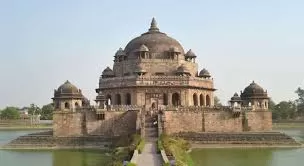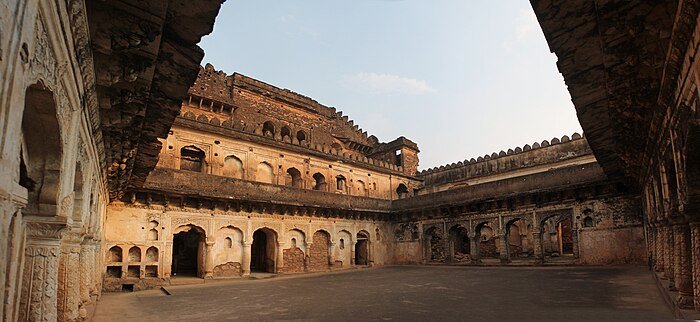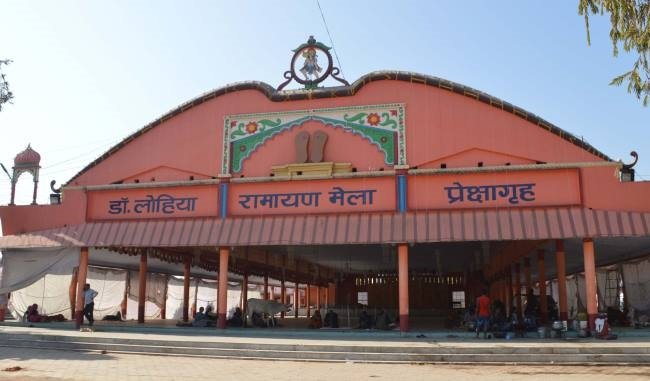A view of kalinjar fort
Kalinjar is a fortress-city in Banda districtof Uttar Pradesh, in India. It was ruled by several dynasties including the Guptas, the Vardhana dynasty, the Chandelas, Solankis of Rewa, Mughal and the Marathas.
The fortress has several temples dating back to the Gupta dynasty of the 3rd–5th centuries. It is strategically located on an isolated rocky hill at the end of the Vindhya Range, overlooking the plains of Bundelkhand.
History of kalinjar
The post of Kalinjar became a force to be reckoned with under the Rajput Chandela rulers who managed this region between the eighth and the thirteenth century AD. The Chandela Kingdom was called Jejakabhubkti and comprised of a few pieces of the advanced Bundelkhand region of the North-Central India. Ruler Yashovarman, well known in Indian history for over and over shocking unfamiliar attack, managed somewhere in the range of 925 and 950 AD, and involved the fortification of Kalinjar. With his capital set up in Khajuraho, he involved Kalinjar as a defensive station and unequivocally strengthened old structures by raising secure dividers, adjusted strongholds and tall watch pinnacles to give an outline of the encompassing regions. Ruler Yashovarman is credited as the organizer of the Chandela administration, and for building the renowned Laxmana Temple.
The fortification again became a force to be reckoned with rehashed intrusions from Sultan Mahmud of Ghazni somewhere in the range of 1019 and 1023 AD. As indicated by Nizamuddin Ahmad, a court antiquarian of Mughal Emperor Abkar the Great, when Mahmud attacked Kalinjar in 1019 AD, he got terrified by a perspective on the gigantic Chandela Army collected inside the Kalinjar Fort. Evidently, the
Sultan petitioned the God for triumph, and King Nanda, proprietor of Kalinjar around then, unexpectedly became apprehensive around evening time on account of a fantasy and escaped with his family and guardians, leaving the stronghold in complete disarray. Following day Mahmud vanquished the fortification absent a lot of opposition and stolen from it. This record probably won’t be altogether obvious as it was composed by Ahmed around 550 years after the fact in light of the legends. By and large, it is noticed that King Gandhadeva, the leader of Kalinjar, honored Sultan Mahmud in 1023 AD to save his realm from obliteration. The post remained under the Chandelas’ standard until in 1202, an immense armed force under Sultan Qutbuddin Aibak recovered it from the Rajputs. Once more, it exchanged possession and returned to the Chandelas in 1211 AD, during the insufficient rule of Sultan Aram Shah in Delhi. The following Sultan of Delhi, Altamash or Iltutmish, attempted to catch Kalinjar a few times and kicked the bucket during one of the ineffective attacks. The continuous Chandela rule then, at that point, went on until the hour of Sultan Allauddin Khilji, when it was again brought under the suzerainty of the Delhi Sultanate. At the point when the Delhi Sultanate became debilitated because of the Timur intrusion of Delhi of 1398, Kalinjar again went under the standard of the Rajputs.
In November 1544, Emperor of the Sur Empire of Delhi Sher Shah Suri assaulted Kalinjar with an enormous power and laid an attack. The Rajput King deciding at Kalinjar around then was Kirat Rai, whose little girl Rani Durgavati was hitched to King Dalpat, the leader of Garha-Mandala (Gondwana). The Gonds assisted Raja Kirat Rai with safeguarding the Fort and out of dissatisfaction Sher Shah chose to blow the fortress dividers up utilizing black powder. Tragically, one of the explosive rockets sent off towards the stronghold dividers boomeranged and hit back Sher Shah himself, consuming him lethally. Sher Shah kicked the bucket around the same time and was covered in the close by town of Sasaram. Sher Shah’s child Islam Shah took the high position of Delhi and around the same time finished his dad’s vision by catching the Kalinjar fortification. Under his guidelines, every one of the inhabitants of the stronghold were mercilessly butchered to vindicate his dad’s demise. After Islam Shah died, the stronghold was recovered by the Rajputs and stayed under the Chandela rule until 1569, when Akbar assaulted and caught it. Kalinjar and the encompassing regions were given to one of the court pearls of Abkar, Raja Birbal, as an individual jagir. Birbal, and was under him till his passing in 1586. A short time later, the post turned out to be essential for the Rewa Kingdom under the Solanki Rajputs, partners to the Mughal Empire. In 1688, Raja Chhatrasal caught Kalinjar fortification from the Mughals. Raja Chhatrasal developed a sensibly immense realm around the Bundelkhand district, and in 1707, as indicated by true Mughal records, Emperor Bahadur Shah I formally conceded this fortification to the Raja as a feature of a ceasefire.
Characteristic of shivlings

Architecture
This fort is situated at a height of 700 feet in Vindhyanchal hill. The total height of the fort is 108 feet, its walls are high and wide, if compared with the wall of China, then it will not work.
Kalinjar Fort is considered to be the largest fort of medieval India, many styles of architecture are shown in this fort like Gupta style, Pratihara style, Panchayatan Nagar style etc.
There are three such temples here which have been built by numerical method. There are seven doors to enter the fort and these doors are decorated with different styles.
Pebul stones of prehistoric times have also been found here. This fort is also mentioned in the Vedas. The temple of Mahadev Bholenath ji is also located in this fort, it is said that Mahadev Bholenath ji had voted for the speed of yesterday by drinking poison on them.
Right behind the temple, a water tank has been made by cutting a mountain. There is a mountain above this temple from where the water relationship resides. Bundelkhand feels like a drought of drought, but no matter how dry it gets, the water will not stop flowing from this mountain.
Here Shiva had defeated the speed of time
The old importance of Kalinjar is from the drinking of Mahadev’s poison, Shiva had voted for the speed of Kaal after taking rest in this fort after drinking the Kalakoot poison from the churning of the ocean.
After the war of Mahabharata, Yudhishthira took a bath in the Koti shrine here.
In Matsya Purad it has been called the undisturbed area of Ujjain and Amarkantak. According to Jain texts and Buddhists, it has been eaten by Calgiri. According to the mention of Vedas, it is considered to be the most mentioned and ancient fort.
Neelkanth temple was built by the serpents
Nilkanth temple is considered to be the most important and revered in the courtyard of Kalinjar. It was built by Nago. This temple has been mentioned in Purado. Shivling is installed in the temple, which has been eaten by the very oldest.
Next to the Niyal Kanth temple is the temple of Kalbhairav, and near such a temple, a rock-cut reservoir has been made which looks very beautiful. It is considered as the Swarga Rohar reservoir. This reservoir is completely covered by the mountain.

Sita’s resting place
Inside this fort, there is a beautiful bed and pillow made by the mountains, it is called Sita ji’s SEZ. According to the old stories, it has been considered as the resting place of Sita.
Here, a reservoir has been built nearby, which is known as Sita Kund ji. Two big water bodies have been built in this fort. Whose water cures extreme diseases. Bathing with this water cures all leprosy.
This fort, built in Kalinjar, about 75 km from Banda district of Bundelkhand, is spread over a distance of several kilometers. This fort was ruled by Chandel Raj for the longest time.
There is no visible evidence of when it was created. Kalinjar Fort is said to be a part of Satyug, it is also known by different names in different times.
In Satyuga it was known as Kirtinagar, in Tretayuga it was known as Madhyagarh and in Dwapar this fort was known as Sinhalagarh and at this time in Kaliyuga this fort is called as Kalinjar.
The rule of Chandel kings on this fort lasted for about 600 years. Chandela kings ruled till 15th century.
During the Mughal period, this fort was gifted by Akbar to Birbal as a jagir. Historians say that after this the fort became under King Kshatrasal and after that King Panna ruled this fort.
Inside this fort we saw many magnificent palaces named Raja and Rani. Talking to the people there, they told that some time ago ancient inscriptions were found here.
It is told about these inscriptions that after the death of Sher Shah on May 1545, his son Islam Shah was duly coronated on the throne of Delhi.
In Kalinjar Fort, we saw very old and wonderful things, as after seeing, we got to learn something or the other and we also got a lot of information about history. That’s why you guys should also go there and know about the Neelkanth temple and its history.


